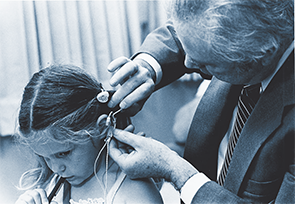
William F. House, MD, with Tracy Husted, the first pediatric cochlear implant patient (Los Angeles, 1981).
Image Credit: House Research Institute
The roots of cochlear implant (CI) technology go back more than 200 years to the 1790s, when Alessandro Volta, who developed the electric battery, placed metal probes into his own ears and connected them to a 50-volt circuit. Upon switching on the flow of current, he experienced a jolt, but, more importantly for auditory science, he also heard a noise.
Explore This Issue
September 2015Since then, many others have contributed to the development of this technology, which is used by more than 219,000 patients worldwide.
Here is a look at some of the critical junctures in the development of CI technology that took place in the second half of the 20th century, fed by advancements from investigators around the world.
1901 (Paris): Eyriès implants Djourno’s coils; alternating current transmitted to the coil produces perception of sound.
1960–61 (Los Angeles): William House and John Doyle begin work on prosthesis; effect electrical stimulation during stapes surgery; implant three patients with a single gold electrode.
1969–70 (Los Angeles): House implants first hardwire five-electrode system in three patients.
1970–71 (San Francisco): Researchers at UC San Francisco implant three patients using a gold two-electrode system and perform a bipolar scala tympani procedure, efforts that would later coalesce into Advanced Bionics.
1972 (Los Angeles): First wearable CI device and first induction system, using a centering coil and attaching magnet, are developed by House’s team.
1973–76 (Paris): Claude-Henri Chouard pioneers the 12-electrode array.
1977–78 (Vienna): Team led by Erwin Hochmair designs and manufactures a passive single-channel broadband analog implant, efforts that later lead to the founding of MED-EL.
1977 (Washington, DC): A team of researchers at the University of Pittsburgh produces and publishes the Bilger Report, which lends credibility to the efficacy of CIs and leads to National Institutes of Health research support.
1978 (Melbourne, Australia): Graeme Clark and colleagues develop multi-channel prototype with an array of 20 electrodes, efforts that would later lead to the founding of Cochlear Ltd., a branch of Nucleus, manufacturer of heart pacemakers.
1978 (Los Angeles, Indiana, and other sites): First multicenter trial of CIs.
1984 (Silver Spring, Md.): FDA approves the House/3M single-channel implant for adults.
1987–2000 (Silver Spring, Md.): FDA approves multiple-channel implant for adults (1985), multiple-channel CI for children two years of age and older (1990), multiple-channel CI for children 18 months and older (1998), and multiple-channel CI for infants one year of age (2000).
Early 1990s: Robert V. Shannon and colleagues develop a noise-band vocoder that simulates CI processing, discovering that four bands of modulated noise are sufficient to allow high levels of speech understanding (Science. 1995;270:303-304)